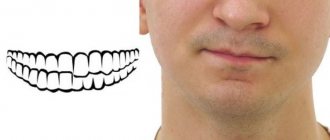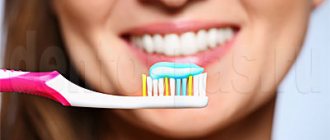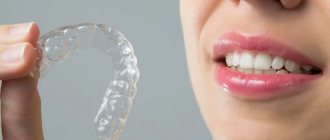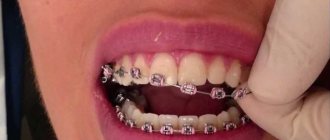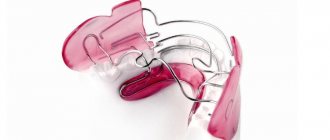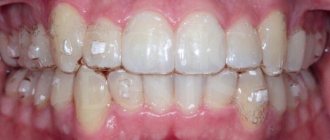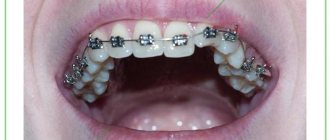Modern orthodontics offers patients various braces to correct their bite. Gone are the days when only metal systems existed for this purpose. At the PROPRICUS clinic you can install transparent braces and solve bite problems almost unnoticed by others.
Make an appointment
About clear braces
An excellent alternative to metal braces are aesthetic transparent designs. Unlike metal ones, they are almost invisible on the teeth. In addition to correcting the bite, transparent ones serve as decoration. Such devices are placed only on the outer side of the dentition, i.e. are vestibular. Aesthetic bracket systems based on the type of power arc fixation can be:
- ligature: the arch is fixed with small transparent or white ligatures - rubber bands,
- non-ligating (self-ligating): here the arch is latched with a special lock, which is installed on each bracket plate.
You can see what transparent braces look like in the photo - the difference in aesthetics with metal ones is really very noticeable.
Only in difficult cases is it recommended to install metal structures. Otherwise, you can avoid spoiling the attractiveness of your smile by using braces with full transparency. They perfectly combine the aesthetics of a smile during treatment and its effectiveness.
Price
The highest cost is for elegant sapphire devices with a delicate platform. Thanks to the innovative technologies used to create such systems, it is possible to achieve highly detailed structures. The effectiveness of treatment can be predicted already at the initial stages of therapy. The cost of invisible braces in Russia varies from 80,000 to 150,000 rubles.
Indications and contraindications
Transparent braces can be used to correct malocclusion, in the presence of interdental spaces and crowding, or curvature of tooth growth (inclination and position in a row).
Contraindications for installation are:
- the presence of acute and chronic periodontal diseases: gums, ligamentous apparatus and alveolar socket,
- diseases of the thyroid gland, endocrine system, blood diseases,
- presence of cancer,
- tuberculosis,
- lack of quality oral hygiene,
- dental implants,
- age up to 12 years or until the primary dentition completely changes to a permanent one.
How much does it cost to install self-ligating (ligature-free) braces on teeth?
The main difference from ligature systems is the absence of additional parts for fastening. Which in turn allows the teeth to move without overcoming the frictional force (which is created by ligatures in other systems), which is much more comfortable.
There are many advantages to such a system:
- They look neater, since the clasps look smaller, although in fact they are about 1 mm larger than the ligature system.
- The manufacturing material does not react with saliva.
- Getting used to it is easier and faster.
- Due to less friction, treatment is faster and lasts about a year on average.
- There is no need to remove “extra” teeth.
- Correction is carried out once every 3 months.
- Quick installation and removal of the system.
- Possibility of use in the presence of periodontal diseases.
The only downside to such a system is the price. How much does it cost to install self-ligating braces for a year? The cost will be 1.5-2 times higher than the ligature system.
What types of transparent braces are there?
You can often find out on the Internet or from friends that transparent braces come in ceramic, plastic and sapphire. In fact, all these varieties are considered aesthetic due to their invisibility on the teeth. But only one type is truly transparent here - sapphire. The rest are either white opaque (or slightly yellowish to more closely match the color of natural enamel) or translucent.
For the manufacture of sapphire bracket systems, monocrystalline aluminum oxide (rather than natural sapphires) is most often used. Often such structures are made self-ligating. They are more comfortable to wear, since the arch puts less force on the teeth. In ligatures, the arch is usually more tightly fixed in the grooves, so immediately after installing them or replacing the ligatures, a person may feel strong pressure (usually the discomfort goes away within 2-3 days).
On a note! There are no bracket systems with a transparent arch. Yes, it can be white and invisible, but underneath the aesthetic coating there is always metal. Since only metal has the qualities necessary for a power arc - flexibility, elongation and strength. If you make an arc from sapphire, ceramic or plastic, it will immediately break.
Sapphire invisible braces
In orthodontic practice, hidden braces made of medical sapphire are used. The device is not only a way to correct a defective bite. It can serve as an original decorating element. The stones are crystal clear. When exposed to sunlight, they sparkle beautifully. The temples are often painted white to make them less noticeable.
Pros and cons of orthodontic systems
Obviously, transparent (sapphire) ones are considered the most aesthetic among other brace systems. After all, people choose them to make the treatment process almost invisible to others.
Let's consider the advantages of such structures:
- increased strength of attachment to teeth: the strongest compared to other aesthetic types,
- high aesthetic indicators: complete transparency, shimmer in the light, preservation of the original color even during long-term use. And the patient likes his smile even with braces,
- comfort when wearing, absence of speech impairments: due to modern manufacturing technologies, the plates are made of a rounded shape, which does not injure the mucous membranes of the oral cavity with sharp edges,
- hypoallergenic material,
- the process of addiction takes place quickly: due to the shape and smoothness of the plates.
The disadvantages of these products are:
- high price: this is one of the most expensive types of orthodontic correction,
- the need for careful treatment and care: so as not to disturb the fixation of the arch or plates - but this is relevant for all bracket systems,
- slower teeth alignment compared to metal ones: sapphire grooves are not metal, but also sapphire. But the power arc is always metal. Therefore, the friction of the arc on sapphire is stronger than the friction of the arc on metal. Due to the strong friction of dissimilar materials, the treatment process lasts several months longer,
- not all orthodontists work with these systems: sapphire plates need to be able to be removed correctly (so that they do not break like glass) and the enamel must be thoroughly polished after removal (usually this is done using a microscope),
- the inability to correct serious bite problems: only metal devices can cope here, and sometimes maxillofacial surgeries are performed.
Is it possible to get lingual braces cheaply?
Many patients are concerned about the question of whether it is possible to fix lingual braces without much damage to their wallet. These are quite expensive devices, most of which are manufactured exclusively for the patient. However, there are options here.
Lingual braces for one jaw
First, it is worth discussing with your orthodontist whether it is possible to install braces on the inside of the teeth on one jaw. This can be in combination with the normal vestibular system or alone in uncomplicated cases. Thus, it is quite possible to install lingual braces on the upper jaw or only on the lower jaw in order to correct the unevenness of only one row of teeth if the patient has the following problems.
- Mild crowding without complications in the anterior jaw.
- Gaps in the front part of the jaw, while the lateral teeth close together correctly.
- Strongly erupted lateral teeth without antagonists.
- Gaps to be closed after tooth extraction.
Partial lingual braces
In some cases, when the patient’s teeth are crooked in a certain place, you can get by with partial lingual braces, which the doctor will fix not on the entire dentition, but only in the area where it is planned to eliminate the local defect. Partial lingual braces with installation will cost the patient almost half as much as a device for the entire dentition.
The final decision on whether it is possible to install a lingual brace system on only one jaw or locally can only be made by the attending physician - taking into account the clinical picture and subject to a stable result.
Budget system models
Another way to save money when installing invisible braces on your teeth is to choose a budget system. The most expensive today are Incognito lingual braces. However, other internal dental braces are no worse in effectiveness than designs from the premium segment. They only differ in the materials of manufacture, the method of fixation and the size of the locks - braces. Table of approximate prices for popular brace systems (for one jaw):
| Bracket system | Cost in rubles |
| STB | from 60 000 |
| Incognito | from 100,000 |
| Win | from 65 000 |
| 2D | from 35 000 |
| In Ovation L | from 25 000 |
In addition to the cost of the braces themselves, the final price of orthodontic treatment will also include diagnosis, installation, regular correction and removal of the lingual brace system. For example, the cost of correcting a malocclusion or crooked teeth using Incognito lingual braces will ultimately cost 300,000 - 400,000 rubles. And if you choose a more budget option, for example, Win or STB lingual braces, then the cost of treatment will be up to 230,000 rubles. So, if you wish, you can install lingual braces inexpensively and become the owner of the smile of your dreams.
Most popular brands
There are very few completely transparent brace systems. They are produced only by the largest manufacturers with high-precision equipment and an impressive research base. Let us next consider popular brands that are known all over the world.
Damon Clear and Damon Clear 2
Damon from the American manufacturer Ormco are represented by several lines - from classic metal ones to the most aesthetic sapphire ones. The latter include non-ligature models Damon Clear and Damon Clear 2, their features are as follows:
- Damon Clear: passive self-ligating system – i.e. the lock cover (located on the bracket) does not press the archwire to the groove, but simply prevents it from falling out. This ensures good sliding of the arc. Small sizes and smoothed edges make the correction comfortable,
- Damon Clear 2: an improved and completely transparent model in which the sliding of the arc in the grooves is almost perfect. Because the special polishing of the groove walls and the absence of their “roughness” prevents friction. “Daimon Clear 2” is placed only on the 6 upper front teeth, and the orthodontist can place other plates from the same manufacturer on the remaining teeth.
Inspire ICE
Inspire ICE braces are also manufactured by Ormco and are made from artificial sapphires. These products are transparent and highly aesthetic. They adhere very firmly to tooth enamel. Unlike Daimon, Inspire ICE designs are ligature. Moreover, the manufacturer notes that the wings of the records are 2 times stronger than those of competitors - therefore the risk of the wing breaking off is minimized. Ormco also claims that the special polishing of the groove makes the arc slide more efficiently than with ceramic plates with a metal groove.
Radiance
For the manufacture of Radiance ligature bracket systems, aluminum monocrystal is used. The plates are perfectly sharpened, thermally polished and highly aesthetic. Manufactured by American Orthodontics. The peculiarities lie in the processing of the base of the plaques - it is rough in the center (to better adhere to the teeth), and smooth along the edges (to make it easier for the dentist to remove the plaque).
Pure
Manufacturer Ortho Technology positions Pure ligature bracket systems as virtually invisible in light or shadow. The plates, made from monocrystalline aluminum oxide, have a low profile, anatomical base and smoothed edges, designed to ensure comfortable wearing without the risk of loss of fixation. And thermal polishing of the grooves promotes their smoothness, good gliding of the arc and painless bite correction.
Aesthetic
Forestadent describes Aesthetic ligature sapphire bracket systems as “programmed” to change to the color of the enamel depending on the lighting, allowing them to blend with a person’s smile. These designs are made of polycrystalline aluminum oxide, and they cannot be called perfectly transparent, like, for example, Damon Clear 2 - rather, translucent.
Advantages and disadvantages
Clear braces are popular due to their many benefits:
- Great aesthetics. White models are almost invisible to interlocutors and barely stand out in photographs and videos.
- Well cut and polished. The edges of ceramic brackets can be smoothed better than metal ones. Consequently, they will injure the oral mucosa less.
- Psychological comfort. Colorless braces are almost invisible. And if they are noticed, they will think that the structures are decorations.
- Hypoallergenic. Acute reactions to aluminum oxide are rare. True, this does not eliminate the risk of developing an allergy to metal parts of the device.
- Versatility. Suitable for patients of all ages. Although they are more often put up by young and mature people.
- Excellent fixation. The plates adhere firmly to the teeth and come off easily when removed.
- Resistant to deformation and staining. Ceramics and sapphire withstand medium-intensity loads well, do not wear off, and do not change color when consuming food or drinks with pigments.
- Fast adaptation. People get used to ceramic models a few days faster than metal ones.
But highly aesthetic bracket systems also have significant disadvantages:
- Expensive. Aluminum oxide models cost at least 2-3 times more than metal structures.
- Large size brackets. Ceramic plates cannot be made as small as metal ones. Therefore, they are felt more strongly in the mouth.
- Relative fragility. Although aesthetic designs are moderately durable, they are inferior in reliability to classic varieties. The most fragile are all-ceramic models of the self-ligating type.
- Extended treatment periods. Due to imperfect sliding of the metal arc in the ceramic grooves, therapy is extended by 0.5-1 year. This point can be circumvented by installing systems with iron grooves - although at the expense of aesthetics.
- Not suitable for complex clinical cases. Aesthetic devices cannot cope with severe occlusion abnormalities.
- It is impossible to place it in case of severe crowding of teeth. If the patient's lower jaw units are too close together and their height and width are small, it will not be possible to attach a large porcelain bracket.
- You need to regulate your diet more strictly. Due to the higher risk of breakage and staining of plates with ligatures, you have to strictly follow a diet.
- When removing there is a high risk of the bracket splitting. The plates often burst and crumble, which causes discomfort, complicates dismantling, and can damage the enamel or gums.
- Rapid accumulation of plaque. Porcelain has high porosity, so microbial plaques and food debris stick to it more actively.
The listed positive and negative aspects concerned systems made of aluminum oxide - ceramic and sapphire. And plastic structures have their advantages and disadvantages.
Plastic braces have few advantages:
- low cost: they are no more expensive than metal systems, and sometimes cheaper;
- good aesthetics: plastic can be painted to match the color of enamel, although the choice of shades is smaller than for ceramics;
- bright solutions: plastic brackets can be supplemented with multi-colored ligatures and get colorful braces.
But there are plenty of disadvantages:
- high risk of allergies - occurs on plastic and metal parts;
- frequent breakdowns - plastic brackets are fragile, easily deformed and chipped;
- strongly absorb pigments;
- require adherence to a strict diet - if this is not done, after a couple of months the brackets will darken or break;
- suitable only for mild bite pathologies;
- extended correction time - the impact of the arc is weaker due to worse sliding, plus heavy loads cannot be placed on fragile plastic brackets;
- active accumulation of bacterial plaque - due to the high porosity of the material.
Also, the plates often peel off from the teeth. And when removed, they can crumble and damage the enamel and gums.
Alternative to clear braces
Let's consider ceramic and plastic (which have already been discussed a little above) as a replacement for transparent brace systems, as well as truly completely transparent correction devices - aligners.
Ceramic systems
The degree of transparency of ceramics can be different - it depends on the method of processing polycrystalline aluminum oxide (from which ceramic systems are made). The patient is offered a wide palette of shades, from which it is easy to choose the most suitable color. Translucent ceramic structures include such popular brands as:
- Reflections: are highly aesthetic and reliable, comfortable, do not cause discomfort,
- Clarity: ligature with a metal groove, and self-ligating - model “SL”. The manufacturer notes that their wearing life is lower than that of analogues,
- Aspire: The metal groove is treated with gold plating, improving not only the glide, but also the overall aesthetics.
The main advantage of ceramic ones is that their cost is slightly lower than that of sapphire ones. And the main drawback is that the aesthetics are also slightly lower than those of completely transparent ones.
Plastic systems
Plastic ones are the most affordable systems. A special plastic is used to make them. The shade of the material can also be matched to the color of tooth enamel, but complete transparency cannot be achieved. Plastic systems include the following brands:
- Elan: the grooves are reinforced with a metal frame that improves the sliding of the leveling arc,
- Spirit MB: ligature with metal grooves. A special fixation system ensures reliable gluing of the plate to the tooth,
- Silkon: ligature and equipped with a metal groove. They are stronger than other plastic ones and more resistant to dyes thanks to a special filler.
Plastic braces can cause allergies. They are much weaker than sapphire ones, and the plates often come off and break. Orthodontic correction on plastic lasts a long time. Plastic also absorbs dyes from tea, coffee, juices, etc., and it is impossible to bleach it. Therefore, aesthetics drop significantly a few months after the start of wearing. The advantages of plastic include its affordability.
Aligners (aligners or aligners)
In addition to transparent braces, you can also use colorless elastic pads to straighten your teeth - they are called aligners or mouthguards. These are removable structures that are becoming increasingly popular every year, especially among young people. The most famous brand is Invisalign aligners.
Mouthguards have the following advantages:
- they are made according to individual casts: therefore, the dentition and onlays interact perfectly,
- lack of reflectivity: therefore, the aligners will not be visible in a photograph that was taken with a flash,
- there is no need to follow a diet: the products can be easily removed for meals,
- the designs are convenient to use: they do not irritate the mucous membranes, do not cause discomfort,
- wide scope of application: aligners truly correct pathologies as efficiently as any aesthetic brace systems.
The negative aspects of these products include:
- high cost: the production of each mouth guard is individual for each patient, and high-quality materials are used for this, as well as modern equipment,
- Patients sometimes forget to put the aligners back on their teeth: therefore, the correction may take longer.
Disadvantages of invisible braces
Like any therapeutic agent, lingual construction for the correction of dentoalveolar anomalies has disadvantages. The characteristic disadvantages of invisible braces include the following features:
- Lingual braces can cause speech problems . Impaired diction goes away on its own only after a period of adaptation.
- Technical difficulties in installation . Their installation will require the services of a highly qualified specialist.
- High price . Invisible braces are considered one of the most expensive orthodontic designs.
Which option should you choose?
Your doctor will help you choose the most suitable design. But personal preferences also play an important role. In addition, it is imperative to be examined for the presence of contraindications to the installation of certain structures. For diagnosis, panoramic x-rays and tele-radiographs are most often prescribed.
The patient’s financial capabilities and the desire to constantly maintain the beauty of his smile also play an important role. After all, to prevent the enamel from darkening from plaque, you will need to regularly have your Air-flow cleaned by your dentist.
In terms of convenience, clear self-ligating braces require less maintenance, according to patient reviews. After all, the absence of ligatures and hooks means that a smaller volume of food will be retained around the plate, which (if not removed in time) will lead to weakening and darkening of the enamel.
Read on the topic: what to choose – ligature or non-ligature braces, and which one is better.
Another advantage of non-ligature ones is that the patient will not need to visit the doctor so often - and go to the orthodontist only to replace the arch (after all, there are no rubber ligatures, and they do not need to be changed). And the replacement of the arch itself occurs several times faster than with ligature ones. After all, snapping the lock into place is much easier than fixing the arc with a rubber band and choosing the strength of its tension.
Are structures completely invisible?
Unfortunately, experts have not yet been able to develop a system in which absolutely all the details would be transparent. All options have a rather complex structure.
The overlays, which are attached to the enamel surface with a special glue, can be made from any material, including completely transparent (sapphire crystals), but there are other elements. For example, the arch that connects all the teeth can only be made of metal. Even if it is coated with a special white dye, it cannot become transparent. The same applies to ligatures or clasps in self-ligating devices. Typically, they are made of metal or rubber, so even the most experienced orthodontist will not be able to make them invisible.
Of course, sapphire braces still look more neat, but they cannot be called completely invisible.
The most optimal treatment option for those patients who are concerned about their appearance is the installation of lingual appliances. They are fixed on the inside of the teeth, so only you and your dentist will know about their existence.
Features of care and wearing
Note: When deciding to install braces, the patient must understand that while wearing them he will have to change his diet, some habits and perform oral hygiene as carefully as possible.
Basic rules of care include:
- brushing your teeth after every meal: the doctor often recommends using preventive toothpastes and special rinses,
- used for cleaning special orthodontic brushes, floss, brushes and irrigator,
- When eating, you need to be careful: hard and sticky foods, as well as very cold and hot foods should be excluded from the diet. And hard fruits and vegetables should be cut into small pieces so as not to bite them. Drinks and foods that can stain are also best avoided.
- avoiding facial injuries: this is important for athletes and workers in various industries.
Be sure to show up for your scheduled orthodontic appointment on time to activate the system. And if suddenly some plate breaks off, comes unstuck, or the arc comes out of the groove, then this is a reason to consult a doctor as soon as possible. There is also no need to delay treatment if your tooth hurts or your gums begin to bleed.
Contraindications for installing braces
Installation of the system is not an invasive procedure, however, the braces still come into one degree or another in contact not only with the teeth, but also with the gums, adjacent tissues of the cheeks, and tongue. Before you find out how much it costs to install lower braces, check out a number of contraindications:
- Diabetes;
- Blood diseases;
- Foci of inflammation in the oral cavity;
- HIV;
- Tuberculosis;
- Immune system diseases;
- Osteoporosis;
- Psychical deviations;
- Other diseases.
Diseases such as periodontal disease, gingivitis, caries - they must first be cured, and only then braces should be installed. Installation is also not recommended if there is increased bleeding of the gums and poor wound healing. When part of the system is damaged, it is difficult to stop the bleeding, and the resulting wounds take a long time and heal poorly.
With osteoporosis, bone tissue is weakened, the pressure of braces on the teeth can play a cruel joke and lead to tooth loss. For diseases of the immune system, any additional stress on the body can have a negative effect, so installing braces is not recommended.
Duration of wearing transparent braces
It is difficult to name the exact period for wearing transparent braces. Dental correction is an individual procedure and also unpredictable.
Usually the defect can be corrected within 2 years. During this time, the patient should make regular visits to the clinic (about once a month). During such visits, minor adjustments to the design, replacement of ligatures and arches are made.
Read on the topic: after removing braces, a retainer will be installed on the back of the teeth. What it is and why it is needed will be explained in a detailed article.
Lingual braces and diction
Installing an invisible braces system is the best option in terms of aesthetics. However, many patients complain that after installing lingual braces, their diction deteriorates. When correcting a bite with lingual braces, the patient may actually develop speech defects during the process of getting used to the device, especially when pronouncing sibilant consonants. For braces that are placed from the inside, this is a normal phenomenon; it completely disappears after two to four weeks, after which the patient continues to lead his usual lifestyle.
What patients say
“I wore sapphire braces for almost two years. I'm happy with the result. My teeth have really straightened out. Moreover, this happened a year after their use, but the doctor explained that if the structure is removed ahead of time, the result may be lost. While I was wearing sapphires, few people noticed them. And if they noticed, they were delighted. They shimmer very beautifully. I didn’t feel any discomfort while wearing it.”
Victoria, 28 years old, review from the website stomatology.rf
“Sapphire braces are certainly good. It’s just not true that they are not noticeable on the teeth at all. Of course, they cannot be compared with metal ones in appearance, but they are clearly visible up close. I went with sapphires. She often performed on stage. Nobody noticed anything. And when a person is close, he can see everything perfectly.”
Yulia, 26 years old, review from the woman.ru forum
Removing teeth before installing braces
In some cases, one or more teeth will have to be removed before braces can be placed. So, with a small jaw, the teeth are too crowded, they do not fit into one row of teeth. Excess elements are removed, after which a braces system is installed to correct the dentition.
There are a number of indications when teeth must be removed:
- Extensive caries damage;
- Presence of a cyst;
- The tooth is very loose;
- The root of the tooth is significantly damaged;
- Osteomyelitis;
- Other.
Wisdom teeth are removed only if they are the cause of malocclusion, are in the wrong position, or have an inflammatory process. In other cases, it is not necessary to remove the wisdom tooth. The doctor makes the decision to remove other teeth based on individual characteristics, and is guided by the fact that facial features are not deformed and functionality is not impaired.
The process of installing braces
Technically, installing braces of any type has its own characteristics, but we can distinguish general stages of the installation process:
- At the first stage, the teeth are treated with a special gel, and then varnish is applied, while the doctor never grinds the teeth, that is, the enamel is not damaged.
- With the help of filling material, the braces are fixed on each tooth, and the process of “gluing” the enamel and the lock occurs.
- An arch is inserted and fixed in each lock using the chosen method. Start from the middle and move to the outer teeth.



